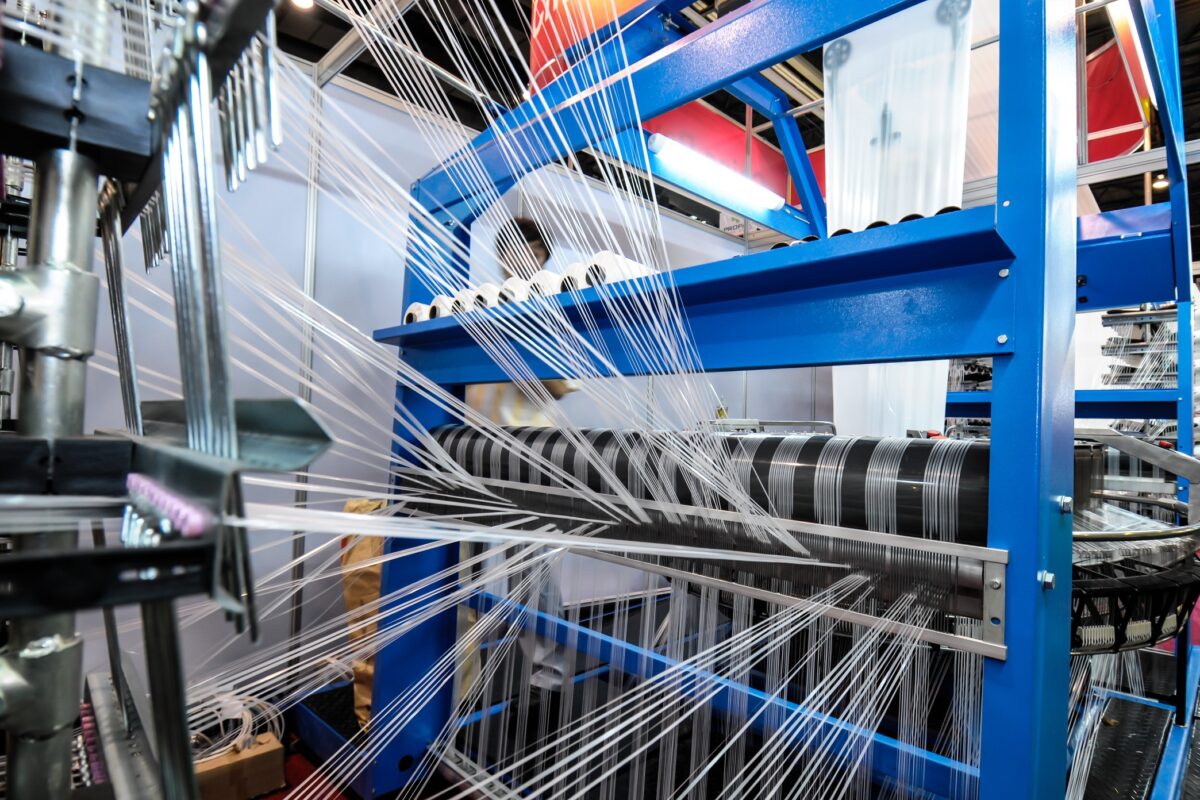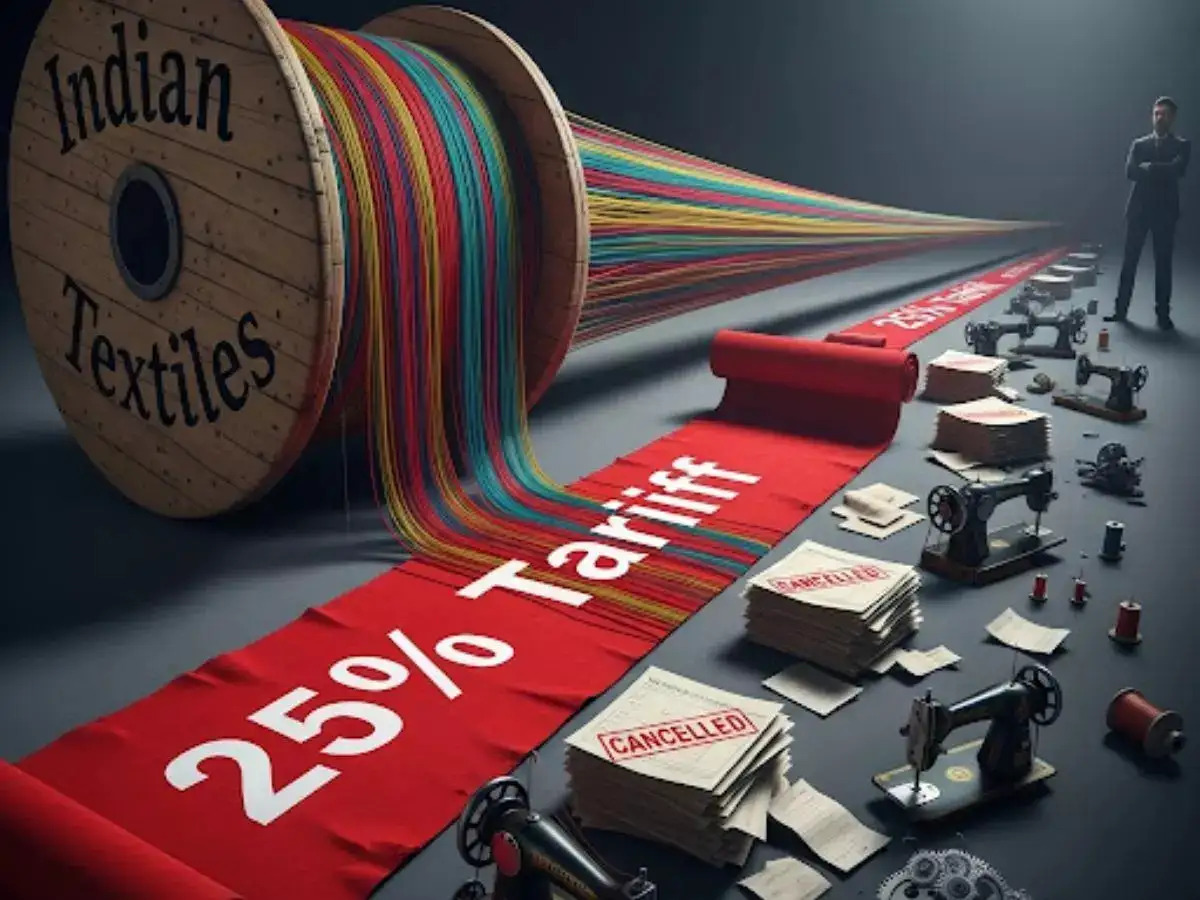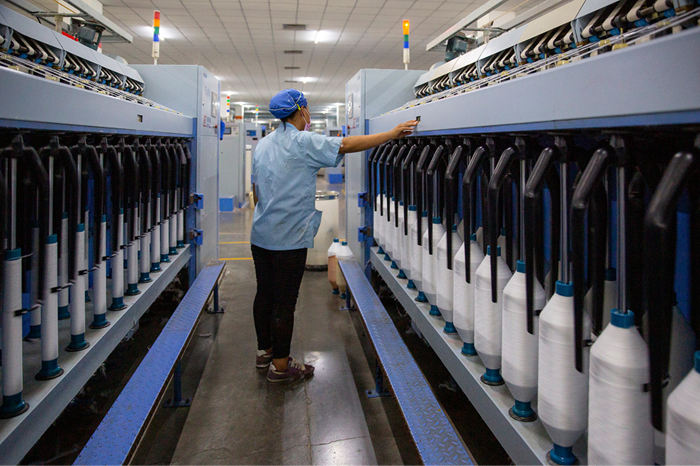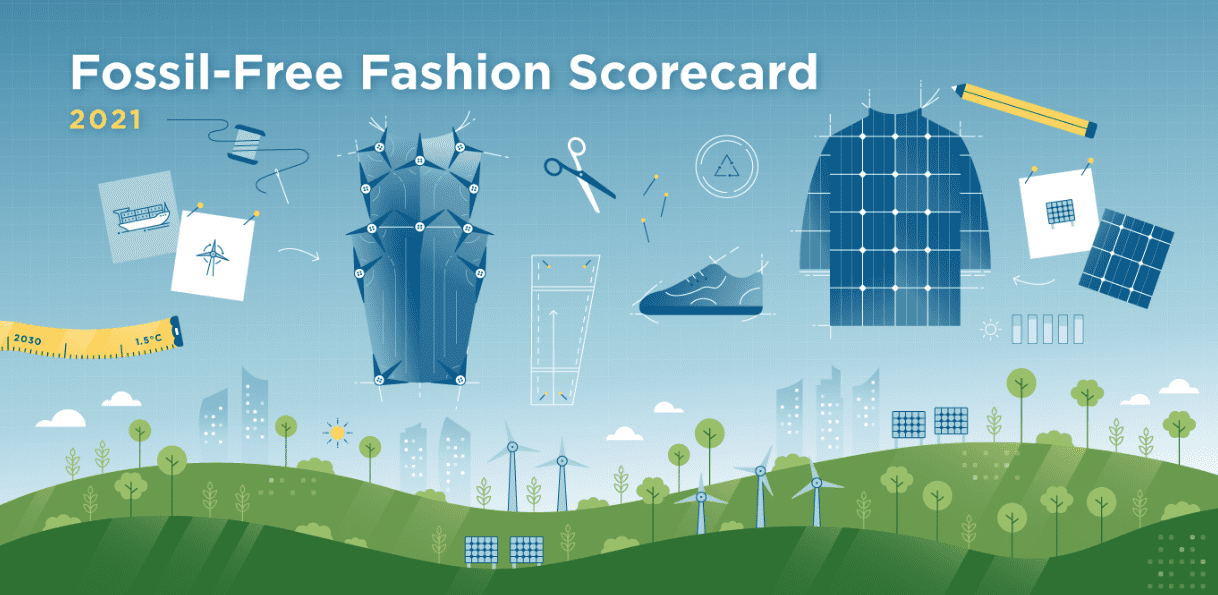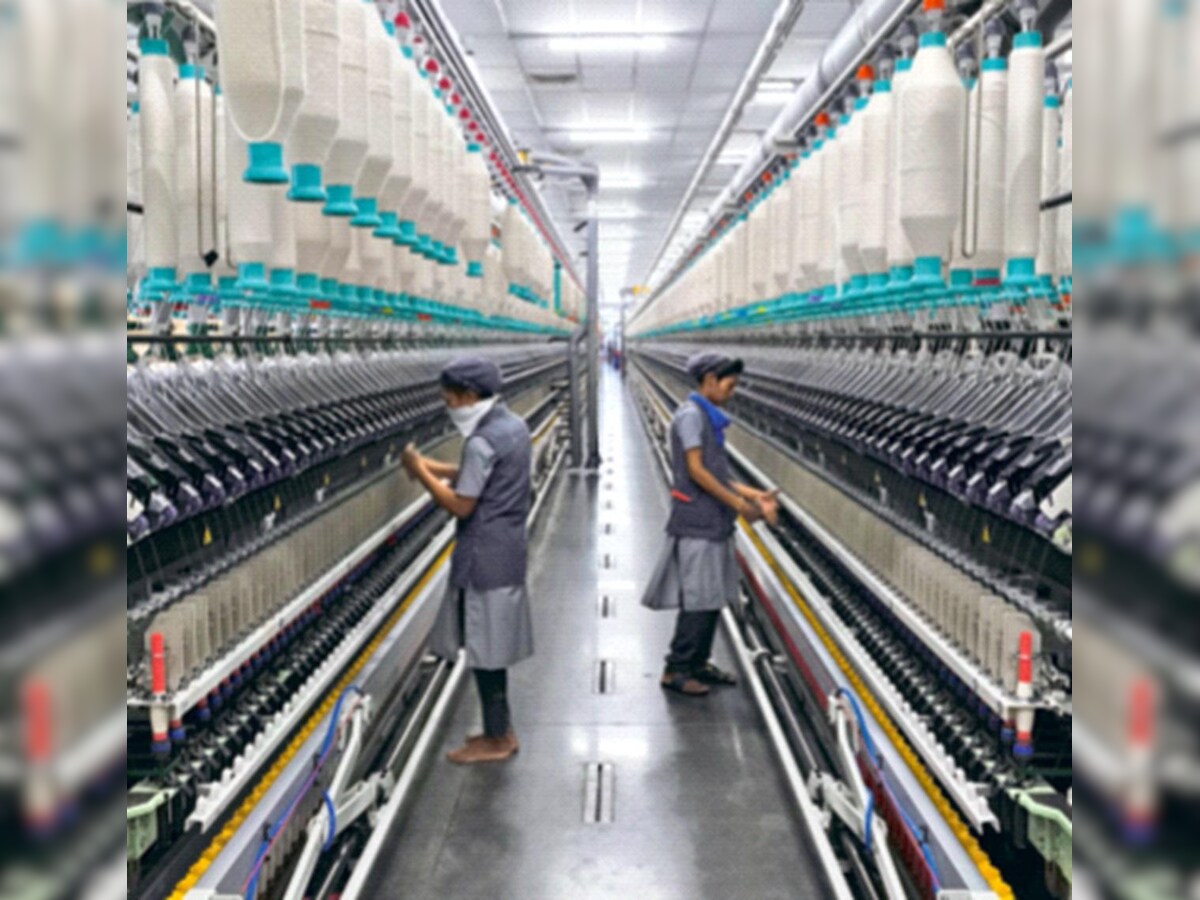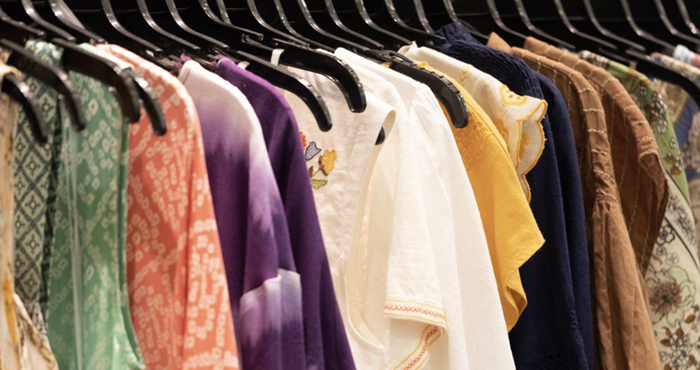FW
Daniel Connolly outlines £62bn sector’s sustainability drive, trade pivots and China links at Intertextile Shanghai 2025
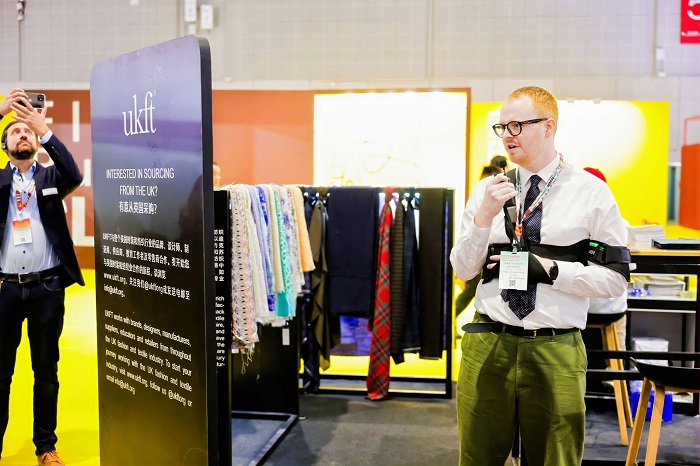
The United Kingdom’s fashion and textile industry is positioning itself for robust global growth while embedding sustainability and circularity into every layer of its supply chain, according to Daniel Connolly, Senior Executive at the UK Fashion & Textile Association (UKFT). Addressing international buyers and suppliers at Intertextile Shanghai Apparel Fabrics – Autumn Edition 2025, Connolly portrayed a sector blending heritage craft with forward-looking innovation. “We are the largest network for fashion and textiles in the UK,” he said. “Our mission is to deliver sustainable growth across the entire value chain — from brands and designers to mills, educators and retailers.”
A £62 billion economic powerhouse
Research commissioned by UKFT and Oxford Economics pegs the industry’s gross value added at £62 billion, supporting 4.3 million jobs — one in every 25 in Britain — and generating £23 billion in annual tax revenues. Britons buy more than 4 billion fashion items a year, underscoring the sector’s weight in domestic retail as well as exports.
Trade flows and shifting markets
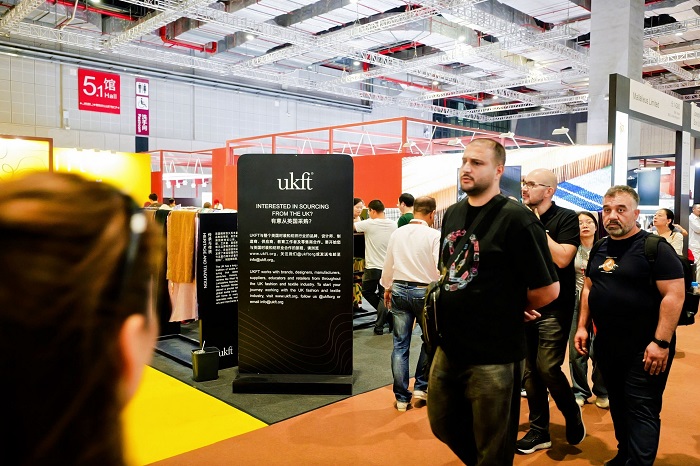
UK textile exports have stabilised since the pandemic, with Europe still dominant, though clothing shipments dipped after 2020 amid Brexit and global disruptions. Imports remain diverse: Bangladesh and China lead non-EU supply, while Italy, France, Spain and Germany stay strong.
Connolly flagged tariffs and geopolitical frictions as 2025 headwinds but said new agreements are widening horizons. The UK’s accession to the Comprehensive and Progressive Agreement for Trans-Pacific Partnership (CPTPP) signals intent to engage markets from Canada to Vietnam, while a free-trade pact with India is nearing completion.
China: Partner in sourcing and sales
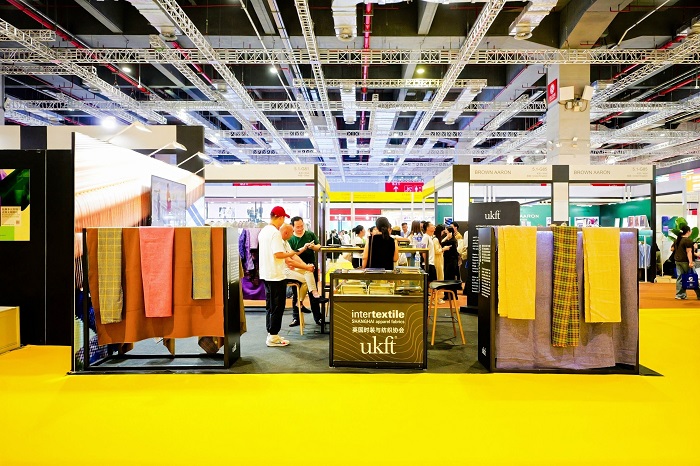
China remains central to UK sourcing and a fast-growing consumer base. Latest figures show £6.3 billion in UK apparel and textile imports from China, versus £284 million in exports. “Our industry depends on Chinese manufacturing for quality as much as price,” Connolly noted. “But we’re also intent on serving China’s expanding premium market.”
Circular economy & compliance
A highlight of Connolly talk was the sector’s pivot to a circular economy. Through its Circular Fashion Innovation Network, UKFT is building infrastructure for recycling, sustainable manufacturing and fibre-to-fibre technologies.
A flagship study shows Britons discard 700,000+ tonnes of non-reusable textiles annually. Pilots with heritage firms such as Begg & Co have turned waste fibres into luxury blankets from recycled wool and cashmere. “The challenge is scaling commercially viable recycling,” Connolly stressed, adding that compliance with new environmental rules is becoming mission-critical for UK operators.
Expanding the global footprint
UKFT has ramped up overseas promotion post-pandemic, sending delegations in 2025 to Vietnam, Tokyo, Atlanta and New York, alongside regular showings at Milano Unica, Première Vision, Pitti Uomo and Paris Fashion Week. Partnerships with Messe Frankfurt and the Worshipful Company of Clothworkers are helping British mills and designers gain traction abroad.
Visitors to Hall 5.1, Stand G84 at Intertextile Shanghai can view samples from 20+ UK companies ranging from luxury woollens to advanced technical fabrics.
Outlook for resilience, innovation and sustainability
Despite trade frictions and slow Brexit aftershocks, Connolly struck an optimistic note. “The EU will remain vital, but Asia, the Americas and the Pacific are just as exciting,” he concluded. “Our focus is resilience, innovation and sustainability — ensuring the UK thrives in an increasingly competitive global textile landscape.”
These efforts, combined with a focus on compliance and innovation, show an industry determined to not only survive but thrive in a complex global environment. UKFT's presence at international events like the one in Shanghai underscores their commitment to finding new partners and solidifying the UK's reputation as a leader in quality, creativity, and sustainable practice.

Greenext Expo 2025 will be held as a major response to ongoing global climate crisis. The event is scheduled to take place from September 26–27, 2025, at the Shanghai Exhibition Center.
Themed ‘A Journey to Sustainability,’ the event is poised to be China’s leading cross-industry summit and exhibition dedicated to sustainable development. It will bring together global sustainability leaders and innovators to forge new solutions for regenerative business practices.
Operating under the guiding principle of ‘Sustain Every Business,’ Greenext Expo 2025 is built on four core pillars: Sustainability, Innovation, Cross-Sector Collaboration, and Business. This year's event will feature an upgraded program that blends showcases, executive dialogues, and public engagement across key sectors like fashion, food and beverage, energy, education, and investment.
Building on a successful debut
Following its successful launch in 2024, the Greenext Expo received widespread praise from both industry leaders and the public. The inaugural event attracted over 4,300 visitors and featured more than 100 brands and businesses. It hosted 23 keynote speeches, 17 panel discussions, and 8 workshops on critical topics, including ESG reporting, climate action, and green consumerism. The event also marked the launch of several landmark publications, such as the China ESG White Paper and a Sustainability Trends Report. Public programs, including a photography exhibition and a collaborative sustainable fashion show, reinforced the expo's mission to merge commerce, creativity, and community.

Thematic zones and flagship initiatives
In 2025, the expo will introduce six curated thematic zones designed to provide clear pathways for sustainable transformation. These include
• Fashion Forward: This zone will highlight a full-chain approach to innovation in fashion, from materials to design.
• Living Earth: This zone will focus on sustainable connections within regenerative agriculture, eco-beauty, and local culture.
• Green for Next: It will present robust solutions for carbon management, green manufacturing, and circular business models.
• Global Navigation: This zone is designed to help Chinese companies build international compliance and sustainable branding capabilities.
• Pulse of Vitality and Art Awakens: These two zones will create immersive spaces that blend lifestyle aesthetics with cultural co-creation.
The expo will also feature a rich array of flagship initiatives. A highlight will be the 15th Anniversary Showcase of the Redress Design Award, which will spotlight emerging sustainable voices in fashion. The Greenext Co-creation Lab will host collaborative sessions in cities like Paris, Hangzhou, and Shanghai to bridge local practices with international dialogue. Other special programs, including the Green Venture Hub and Future Leaders Academy, are designed to foster long-term strategic change across various industries.

Shaping the future
This year's expo will also develop its public engagement efforts through an enlarged EcoLife Neighborhood, interactive art installations, and gamified sustainability experiences. An urban ‘green passport’ initiative will integrate the event with commercial venues across Shanghai, aiming to make green living more accessible and appealing to a wider audience.
Reflecting on the future, Dr Hong Zheng, Founder, Greenext, emphasizes on the importance of the event as a catalyst for change. The event was launched in 2024 in Shanghai with humility and curiosity, he says. The energy from thousands of attendees and the resonance across industries affirmed that sustainability is no longer a distant vision but a shared imperative, he adds.
Dr Zheng concludes by stating, the event continues to explore how sustainable ideas can be developed in 2025, under the theme 'A Journey to Sustainability. It also explores how industries can collaborate, and how culture can amplify impact. The event is thus set to be a stage for connection, a space for experimentation, and a movement of purpose.
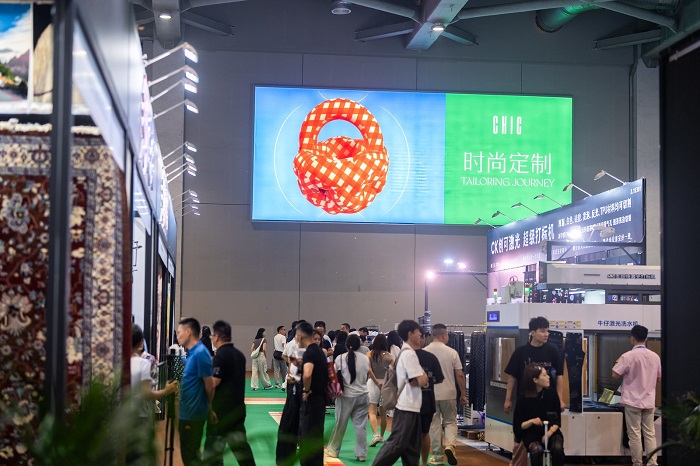
With over 650 exhibitors showcasing their products across 60,000 sq m, the China International Fashion Fair (CHIC) Autumn 2025, consolidated its position as Asia’s premier fashion trade show. The fair was held from September 2-4, 2025 and attracted more than 60,000 visitors. The event served as a critical platform for business, innovation, and networking.
Based on the theme, ‘New Intelligence, New Products, New Scenes,’ the trade fair highlighted the Chinese apparel industry's shift toward technology, sustainability, and sophisticated supply chains. The ‘Autumn Picnic’ metaphor set a relaxed, welcoming tone, fostering a sense of community and collaboration that blended business with creativity.
According to Chen Dapeng, President, China National Garment Association, more than just an exhibition; CHIC is a strategic hub where the future of the fashion economy is shaped. The event provides international brands with essential access to partners, distribution channels, and market opportunities in China, he asserted
Showcasing industry innovation and trends
The fair's exhibitors presented a comprehensive view of the industry, from intelligent manufacturing and digital supply chain solutions to production processes aligned with ESG (environmental, social, governance) criteria. Over 100,000 product variants, or SKUs, were on display, ranging from outdoor and streetwear to avant-garde designer collections.
A major highlight was the global recognition of Chinese designer labels. Brands that had previously shown at prestigious international events like Pitti Uomo in Florence showcased their collections, demonstrating that Chinese design is now a major force on the international stage. Labels such as May D. Wang exemplified a new creative generation that blends traditional craftsmanship with innovative concepts and cultural identity.
Other key trends included the growth of lifestyle-oriented apparel and sportswear from market leaders like Zhangzhen Jeans and Muye Zhanfang. The ‘Guo Feng’ or national style, a prominent expression of cultural pride among younger generations, was also well-represented by brands such as Shang Jiu Kai and Jixiang Yijia. Technological innovations were a major draw, with companies like PSAI and Feiliu Tech presenting smart production equipment, 3D printing, and AI solutions that highlight the industry's digital edge.
A gateway for international brands
CHIC Autumn 2025 underscored China's evolution from a manufacturing hub to a global innovation leader, creating unique opportunities for international brands. Authenticity and quality, particularly for products ‘Made in Europe,’ remain highly valued. A strong digital presence on platforms like Tmall, JD.com, and Douyin is now considered essential for market success. The fair also emphasized the importance of agile supply chains, flexible production, and cultural sensitivity to strengthen brand acceptance.
Despite a decline in international exhibitors since the pandemic, CHIC remains a vital bridge for global companies. Italian delegations with brands like Franco Giazzi and Cinzia Caldi, as well as German brand Studio Ayasse, expressed unanimous satisfaction with the event.
The fair attracted 60,977 professional visitors from 83 countries, with a significant majority from within China. The visitor list included global retail giants like Shein and Galeries Lafayette, leading Chinese brands like JNBY and Ellassay, and major e-commerce platforms such as Tmall and Taobao.
Sustainability and innovation at the forefront
Sustainability was a central theme at CHIC, with a dedicated Sustainable Innovation Zone and the 2025 Circular Stewardship Fashion Conference. The event brought together experts from organizations like the National Development and Reform Commission and the Delegation of the European Union to discuss building a closed-loop textile industry and implementing ESG best practices.
Ashwin Chandran has been appointed the new chairman of the Confederation of Indian Textile Industry (CITI), effective September 18, 2025. He takes the leadership position from Rakesh Mehra, whose term concluded after CITI's 67th Annual General Meeting (AGM).
A seasoned industry leader, Chandran is the Chairman and Managing Director of Precot, a prominent cotton mill with operations across several Indian states. He previously served as the chairman of the Southern India Mills Association (SIMA).
The new leadership team also includes Dinesh Nolkha as the new deputy chairman and Shreyaskar Chaudhary as the new vice chairman.
An eminent figure in the textile sector, Nolkha is the Chairman and Managing Director of Nitin Spinners., a leading manufacturer of cotton yarn and knitted fabrics. He is a certified Chartered Accountant and a former president of the Mewar Chamber of Commerce and Industry.
Known for his focus on sustainability, Chaudhary is the Managing Director of Pratibha Syntex The company is a pioneer in ethical and sustainable practices, holding certifications as India's first Fair Trade Certified and ZDHC Certified Apparel Manufacturer.
Outlining the two essential priorities for the Indian textile and apparel sector, Chandran says, the most urgent task is to address the severe challenge posed by a new 50 per cent tariff imposed by the United States on Indian products starting on August 27, 2025.
The longer-term goal is to ‘futureproof’ the Indian textile and apparel industry, primarily composed of small and medium-sized businesses (MSMEs). The strategy focuses on improving the industry's ability to compete on the world stage; placing a greater emphasis on new technologies, ethical practices, and environmental stewardship, investing in skill development and knowledge sharing to help businesses grow both domestically and internationally and enabling companies to fully capitalize on existing and future free trade agreements (FTAs), he adds
The Aid by Trade Foundation (AbTF) is seeking public feedback on its updated Cotton made in Africa (CmiA) standard, a key framework for sustainable cotton production. Interested parties have until November 17, 2025, to provide comments on the draft of Version 5.0, helping to shape one of the world's largest standards for sustainable cotton.
This latest version focuses on three main areas: increasing clarity, reprioritizing objectives, and aligning with new corporate reporting requirements. The standard aims for greater precision by reducing and simplifying indicators, making them easier to understand and implement. Objectives are being reprioritized to strengthen key areas like biodiversity, climate resilience, and cooperation between companies and farmers. Finally, the update ensures that indicators for human rights and risk management meet the growing demands for corporate due diligence and sustainability reporting.
Alexandra Perschau, Head- Standards & Outreach Department, AbTF, encourages public participation, calling it an excellent opportunity to actively participate in shaping our approach to supporting small-scale farmers producing cotton in Africa, to protecting biodiversity, and to giving companies access to the sustainable resources they need to fulfill their due diligence obligations.
The revision process began in spring 2025 with input from partners and stakeholders in Côte d’Ivoire, as well as an analysis of past verification results and new findings in sustainable cotton cultivation. After the public consultation closes and a technical advisory group provides its feedback, the draft will be submitted to the AbTF Board of Trustees for approval. If approved, Version 5.0 will be implemented in 2026.
Cotton made in Africa (CmiA) is an internationally recognized standard that provides transparent traceability for sustainably produced cotton. Over 30 per cent of African cotton is CmiA-verified, and the standard is GMO-free, with a strong focus on protecting human rights, biodiversity, soil, and water. More than 60 textile companies and brands use CmiA cotton, supporting around 800,000 small-scale farmers and their communities.
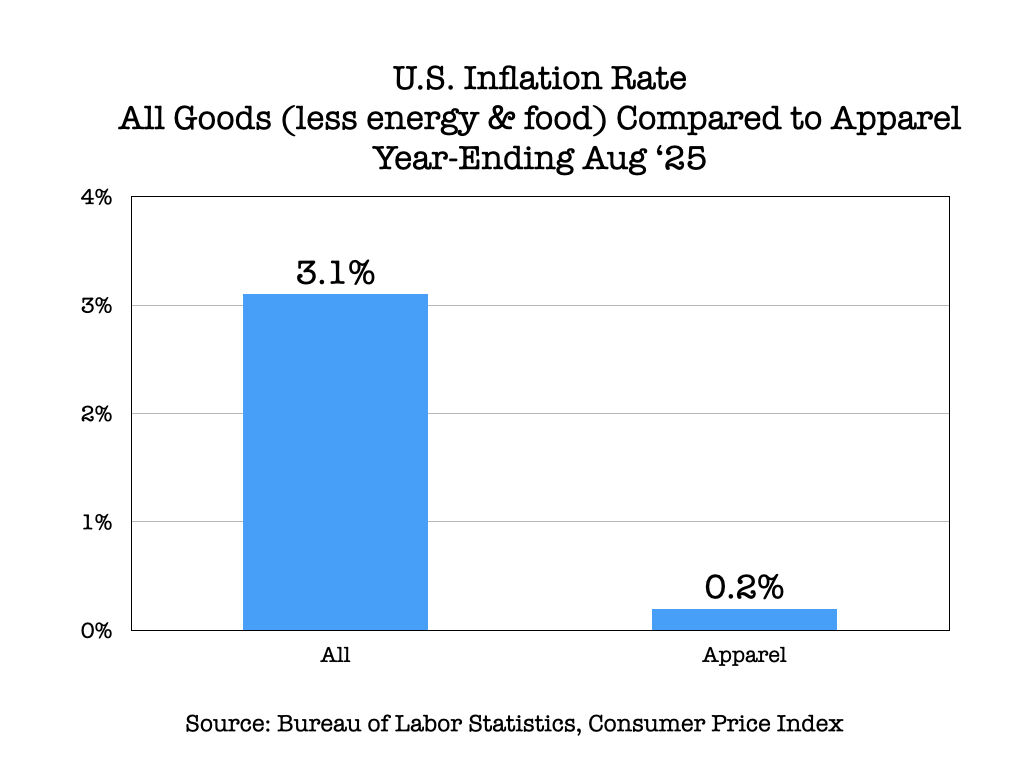
The latest data from the Bureau of Labor Statistics (BLS) indicates that while overall US inflation remains high, the apparel sector continues to give a welcome break to consumers. However, a closer look at the data suggests that this period of stability may be nearing an end. According to the BLS Consumer Price Index (CPI), the inflation rate for all goods (less energy and food) stood at a robust 3.1 per cent for the year ending in August 2025. In stark contrast, apparel prices rose only 0.2 per cent over the same period. This gap highlights a continuing trend where the clothing industry is absorbing costs rather than passing them on to shoppers.
August records a jump
Despite the low annual figure, the monthly data reveals a critical change: apparel inflation jumped sharply by 0.5 per cent in August, its highest monthly increase since February. This sudden rise suggests that the cumulative effects of market uncertainties and import tariffs may finally be affecting clothing prices at the consumer level.
The monthly volatility in the apparel index is a well-established pattern, often influenced by seasonal sales and new product releases. However, the August spike is particularly noteworthy, hinting that a more sustained upward trend may be on the horizon.
Table: US monthly apparel index
|
Month |
Seasonally adjusted change from preceding month |
|
February |
+0.6% |
|
March |
+0.4% |
|
April |
-0.20% |
|
May |
-0.40% |
|
June |
+0.4% |
|
July |
+0.1% |
|
August |
+0.5% |
Fed's dilemma
The difference between overall inflation and apparel inflation puts the Federal Reserve in a precarious position. The central bank has a stated inflation target of 2 per cent, and with core inflation running at 3.1 per cent, the Fed is under pressure to maintain a tight monetary policy.
However, the situation is complicated by a softening labor market. Typically, a weakening job market would provide a case for the Fed to cut interest rates to stimulate economic activity. The combination of persistent inflation and a slowing labor market creates a difficult and politically charged environment for the Fed. A decision to cut rates to support employment could risk further fueling inflation, while maintaining high rates could deepen a labor market downturn.
The recent jump in apparel prices a category that has been a deflationary force for much of the past year adds another layer of anxiety to the Fed's upcoming decision. It raises the question of whether the recent increase is a blip or the beginning of a broader pass-through of costs to consumers, which would make the Fed's inflation fight even more challenging.
Toray Industries and MAS Holdings have launched a new joint venture company (JVC), Toray MAS Apparel India, to produce apparel within and for India's rapidly growing market. Formally signed in June, the partnership will include the establishment of a new manufacturing facility at the MAS Apparel Park in Odisha.
Operations at this facility are slated to begin in early 2026. The plant aims to serve both current and future customers in the region, meeting the rising demand for high-quality, innovative textile solutions.
Highlighting the goals of this venture, Teruo Funahashi, Managing Director, Toray Hong Kong, describes the new company as a ‘garment stronghold’ that will strengthen the partnership between Toray and MAS by leveraging their respective capabilities.
Suren Fernando, Group CEO, MAS Holdings, terms this collaboration a ‘significant step forward’ in strengthening the company's global supply network. The Odisha facility will be crucial in supporting customer needs, driving innovation, and fostering regional economic development, he notes.
The collaboration brings together MAS Holdings' extensive apparel manufacturing expertise and Toray Industries' advanced material technologies. The new facility is also being designed with a strong focus on sustainability. It will incorporate renewable energy solutions like rooftop solar panels, energy-efficient technologies, and advanced water and wastewater management systems. The facility is also being built to ensure universal accessibility and integrate environmentally responsible waste and chemical management practices, aligning its future operations with both environmental stewardship and social responsibility.
At its recent Extraordinary General Meeting, the shareholders of Rieter Holding approved all proposals from the Board of Directors.
They agreed to reduce ordinary capital by lowering the nominal value of shares, as well as increasing it through a rights issue and a private placement. They also approved the Board of Directors’ proposal to reintroduce the capital band and amend the company’s Articles of Association. The meeting was attended by 176 shareholders, their representatives, and an independent proxy.
A leading global supplier for manufacturing yarn from staple fibers in spinning mills, Rieter develops and manufactures machinery, systems, and components used to efficiently convert natural and man-made fibers into yarns. The company’s advanced spinning technology supports sustainability in the textile industry by minimizing resource use. The company has been in business for 230 years, operates 18 production sites in ten countries, and employs a global workforce of around 4,560 people, with approximately 15 per cent located in Switzerland.
To create new revenue streams as well as ease pressure on its retail business due to the US tariffs, Shein Group is opening its Chinese apparel manufacturing network to other fashion brands.
Known as Xcelerator, the company's new initiative allows brands to tap into Shein's supply chain- known for its ability to turn around new designs in as little as 5 to 7 days. This service is available to brands on the condition that they open a store on Shein's online marketplace.
Shein has been formally recruiting brands for the program over the past two months after nearly two years of preparation and testing. Currently, about 20 brands, including French fashion label Pimkie and Filipino designer Jian Lasala, are using the service, which is being promoted through a new website launched in August.
Beyond manufacturing, Xcelerator also offers a suite of services that smaller brands often can't access at low costs, including sample development, warehousing, sales, and order fulfillment.
According to a Shein spokesperson, the program is designed to help brands overcome value-chain challenges by offering direct-to-consumer services, on-demand production, and global sales access to scale their creativity worldwide.
By selling access to its supplier network, Shein is building a new growth pillar to counter the impact of recent US policy changes. The removal of tax exemptions for small parcels from China has created uneven sales trajectories for Shein's core business of selling low-cost apparel. While Shein's US sales have been stronger than those of rival PDD Holdings' Temu platform, the company is still grappling with a volatile trade environment.
Unlike open-access platforms like Alibaba and 1688.com, Shein's model links supplier access to participation on its marketplace. This strategy aims to both leverage its extensive manufacturing network and attract more fashion brands to its platform, which is an important step as it faces increased competition and ongoing hurdles with its planned initial public offering. Shein, which is now headquartered in Singapore, has confidentially submitted a draft prospectus for a listing in Hong Kong.
A leading online marketplace, the Carousell Group is expanding into physical retail with the launch of its first branded brick-and-mortar store, Carousell Luxury. Located on Singapore's renowned Orchard Road at The Centrepoint, the 1,400-sq-ft store is set to officially open on September 23. It offers second-hand luxury handbags and accessories from top brands like Louis Vuitton, Chanel, and Yves Saint Laurent.
According to Tresor Anne Tan, Director - Client Relations, Carousell Group, the new store addresses a growing trend among luxury consumers who are more conscious of a product's economic value and sustainability. Buyers can purchase high-end items at a fraction of their original cost, often in excellent condition, she notes. A physical presence also offers a key advantage over online sales: it allows buyers to inspect products in person and rely on the store's in-house authentication team. A team of five appraisers meticulously checks each item's materials, stitching, and embossing to ensure authenticity.
For sellers, the store offers a ‘net-earnings model,’ where they agree on a specific payout amount upfront. Carousell takes a 25 to 30 per cent cut of the consignment price, which covers services like digital marketing and photography. This model ensures sellers are not affected by any sales or promotions the store might run, Tan explains. The store also provides a direct buy-out option, allowing sellers to get paid upfront at a slightly lower rate, as Carousell assumes the risk if the item doesn't sell, she adds.
Since its soft launch, Louis Vuitton has been the top-selling brand, accounting for one in four bags sold, followed by Chanel and Gucci. The store's clientele consists mainly of professionals, managers, executives, and technicians aged from their mid-20s to late 50s. While most sellers are local, the store has also drawn overseas buyers from countries like South Korea and China.

